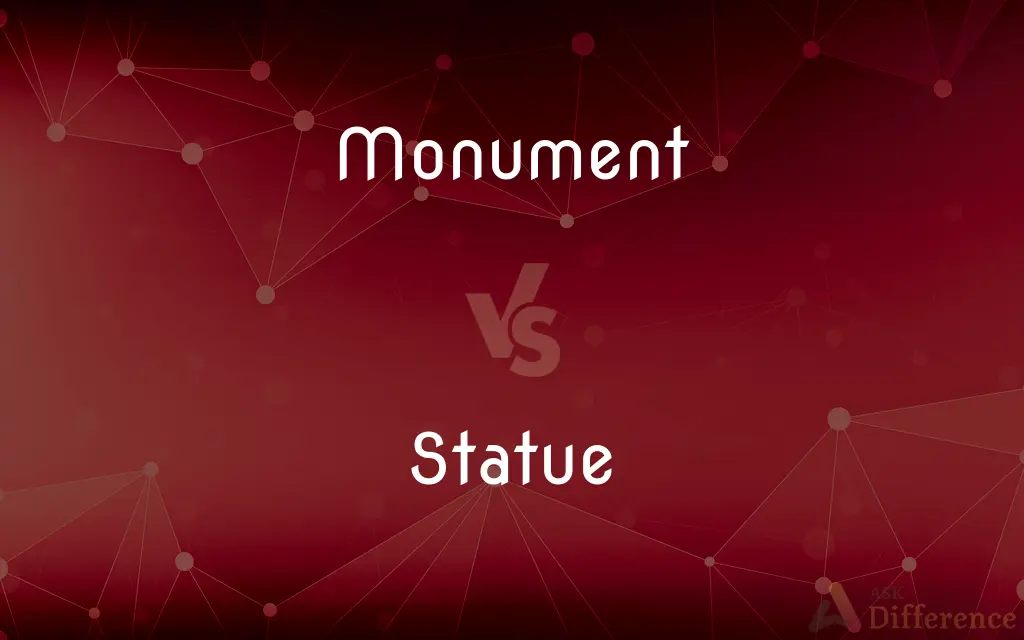Monument vs. Statue — What's the Difference?
Edited by Tayyaba Rehman — By Maham Liaqat — Updated on April 4, 2024
A monument is a structure or site commemorating a person, event, or concept, often historical; a statue is a three-dimensional sculpture representing a figure.

Difference Between Monument and Statue
Table of Contents
ADVERTISEMENT
Key Differences
A monument serves as a physical testament to historical figures, events, or ideas, designed to preserve memory and inspire future generations. Whereas a statue is specifically a sculptural representation of an entity, typically a person or deity, focusing on artistic and realistic depiction.
Monuments can encompass a wide range of structures, including statues, but also plaques, buildings, and more, reflecting a broader commemorative purpose. On the other hand, statues are singular in their form, concentrating on the art of sculpture to convey their message or honor their subject.
While monuments often have a significant cultural, historical, or political significance intended to convey a message or provoke thought about the past, statues can also serve decorative or celebratory functions, apart from their commemorative roles.
The creation of a monument is usually motivated by the desire to mark a significant location, event, or anniversary, imbuing a place with historical or cultural value. In contrast, the creation of a statue is often driven by the desire to capture the likeness and spirit of its subject in a tangible form.
Monuments can be found in diverse locations, from urban centers to natural landscapes, marking places of historical importance or memorializing events. Statues, while they may also stand in significant locations, are more focused on the representation of the figure itself than on the broader context of its placement.
ADVERTISEMENT
Comparison Chart
Definition
A structure commemorating an important person, event, or idea.
A sculpture representing a figure.
Purpose
To memorialize and inspire reflection on historical significance.
To artistically depict a specific figure or entity.
Composition
Can include various forms: statues, plaques, buildings.
Primarily composed of sculptural art representing a figure.
Significance
Cultural, historical, or political importance.
Can be commemorative, decorative, or celebratory.
Location
Varied, often marking significant historical sites.
Often placed in significant locations but focuses on the figure itself.
Compare with Definitions
Monument
A structure erected to commemorate persons or events.
The Lincoln Memorial is a monument honoring Abraham Lincoln.
Statue
A sculptural work placed in public for commemoration or decoration.
A new statue was unveiled in the city square to honor healthcare workers.
Monument
An inscribed stone or plaque commemorating a person or event.
The plaque at Gettysburg is a monument to the soldiers who fought there.
Statue
An artistic representation of a figure, carved or cast in materials like bronze, stone, or marble.
The bronze statue in the park depicts a famous local poet.
Monument
A memorial building or structure of historical significance.
The ancient pyramids of Egypt are monuments of architectural achievement.
Statue
A piece of sculpture representing deities or religious figures.
The statue of Athena in the Parthenon was a symbol of wisdom and warfare.
Monument
An enduring symbol of an important aspect of culture or history.
The Statue of Liberty is a monument representing freedom and democracy.
Statue
A three-dimensional sculpture of a person, animal, or mythical figure.
The statue of David by Michelangelo is a renowned work of art.
Monument
A marker or statue signifying a notable historical event.
The Vietnam Veterans Memorial is a monument to those who served in the Vietnam War.
Statue
A figure sculpted in a realistic or abstract style, intended for visual appreciation.
The modern art museum features a statue abstractly representing human resilience.
Monument
A monument is a type of structure that was explicitly created to commemorate a person or event, or which has become relevant to a social group as a part of their remembrance of historic times or cultural heritage, due to its artistic, historical, political, technical or architectural importance. Some of the first monuments were dolmens or menhirs, megalithic constructions built for religious or funerary purposes.
Statue
A statue is a free-standing sculpture in which the realistic, full-length figures of persons or animals or non-representational forms are carved or cast in a durable material such as wood, metal or stone. Typical statues are life-sized or close to life-size; a sculpture that represents persons or animals in full figure but that is small enough to lift and carry is a statuette or figurine, whilst one more than twice life-size is a colossal statue.Statues have been produced in many cultures from prehistory to the present; the oldest-known statue dating to about 30,000 years ago.
Monument
A statue, building, or other structure erected to commemorate a notable person or event
A monument to Magellan is in the main square of the city
A simple stone monument marked the nearby crash site
Statue
A carved or cast figure of a person or animal, especially one that is life-size or larger.
Monument
A structure, such as a building or sculpture, erected as a memorial.
Statue
A three-dimensional form or likeness sculpted, modeled, carved, or cast in material such as stone, clay, wood, or bronze.
Monument
An inscribed marker placed at a grave; a tombstone.
Statue
A three-dimensional work of art, usually representing a person or animal, usually created by sculpting, carving, molding, or casting.
Monument
Something venerated for its enduring historic significance or association with a notable past person or thing
The architectural monuments of ancient Rome.
Traditions that are monuments to an earlier era.
Statue
(dated) A portrait.
Monument
An outstanding enduring achievement
A translation that is a monument of scholarship.
Statue
(transitive) To form a statue of; to make into a statue.
Monument
An exceptional example
"Thousands of them wrote texts, some of them monuments of dullness" (Robert L. Heilbroner).
Statue
The likeness of a living being sculptured or modeled in some solid substance, as marble, bronze, or wax; an image; as, a statue of Hercules, or of a lion.
I will raise her statue in pure gold.
Monument
An object, such as a post or stone, fixed in the ground so as to mark a boundary or position.
Statue
A portrait.
Monument
A structure built for commemorative or symbolic reasons, or as a memorial; a commemoration.
There is a monument on the town green to the soldiers who died in World War I.
Statue
To place, as a statue; to form a statue of; to make into a statue.
Monument
An important site owned by the community as a whole.
Statue
A sculpture representing a human or animal
Monument
An exceptional or proud achievement.
Monument
An important burial vault or tomb.
Monument
Any grave marker.
Monument
A legal document.
Monument
A surveying reference point marked by a permanently fixed marker (a survey monument).
Monument
A pile of stones left by a prospector to claim ownership of ore etc. found in a mine.
Monument
(surveying) A natural or artificial object used as a reference point.
Monument
A surviving record.
Monument
(transitive) To mark or memorialize with a monument.
Monument
Something which stands, or remains, to keep in remembrance what is past; a memorial.
Of ancient British artA pleasing monument.
Our bruised arms hung up for monuments.
Monument
A building, pillar, stone, or the like, erected to preserve the remembrance of a person, event, action, etc.; as, the Washington monument; the Bunker Hill monument. Also, a tomb, with memorial inscriptions.
On your family's old monumentHang mournful epitaphs, and do all ritesThat appertain unto a burial.
Monument
A stone or other permanent object, serving to indicate a limit or to mark a boundary.
Monument
A saying, deed, or example, worthy of record.
Acts and Monuments of these latter and perilous days.
Monument
A structure erected to commemorate persons or events
Monument
An important site that is marked and preserved as public property
Monument
A burial vault (usually for some famous person)
Common Curiosities
What materials are commonly used to make statues?
Statues are commonly made from materials like bronze, stone, marble, and wood, depending on the desired finish and durability.
What is the main purpose of a monument?
The main purpose of a monument is to commemorate and memorialize significant persons, events, or ideas, inspiring reflection on historical significance.
How do cultures influence the design of monuments and statues?
Cultural values, historical contexts, and artistic traditions greatly influence the design, symbolism, and placement of monuments and statues, reflecting the identity and heritage of the people who create them.
How do monuments differ from memorials?
While both monuments and memorials serve to commemorate, monuments can celebrate achievements or historical significance, whereas memorials specifically honor the memory of people and events, often with a somber tone.
Are monuments and statues only found in public spaces?
While commonly found in public spaces for communal engagement and commemoration, smaller monuments and statues can also be found in private collections and spaces.
How do monuments and statues contribute to historical education?
They serve as tangible links to the past, providing visual and contextual cues that aid in the understanding and appreciation of history and culture.
How has the concept of monuments evolved over time?
The concept of monuments has evolved to encompass not only traditional commemorative structures but also abstract and conceptual art pieces that challenge viewers’ perceptions of history and memory.
Can a statue be considered a monument?
Yes, a statue can be considered a monument if it serves a commemorative purpose, marking a person or event of historical importance.
What role do monuments and statues play in preserving cultural heritage?
They play a crucial role in preserving cultural heritage by embodying historical narratives, artistic expressions, and the collective memory of a society, making the past accessible to future generations.
What is the significance of the location for monuments and statues?
The location is significant for both, but especially for monuments, as it often relates to the historical event or person being commemorated. Statues’ locations can enhance their visibility and relevance, but the focus remains on the figure itself.
What is the process for commissioning a public monument or statue?
Commissioning a public monument or statue typically involves proposal submission, approval by governing bodies or committees, fundraising, artist selection, and careful planning of the design and installation.
Can the creation of a monument or statue be controversial?
Yes, the creation and placement of monuments and statues can spark controversy, especially if they represent contentious historical figures or events, or if there's disagreement over the use of public space.
How do monuments and statues impact community identity?
They significantly impact community identity by reflecting shared values and history, serving as focal points for reflection, celebration, and sometimes protest, thereby shaping the communal sense of self.
Are there environmental considerations for placing monuments and statues?
Yes, environmental considerations include the impact on the landscape, material durability under weather conditions, and ensuring that the installation does not harm the surrounding ecosystem.
Share Your Discovery

Previous Comparison
Vise vs. Clamp
Next Comparison
Villein vs. SerfAuthor Spotlight
Written by
Maham LiaqatEdited by
Tayyaba RehmanTayyaba Rehman is a distinguished writer, currently serving as a primary contributor to askdifference.com. As a researcher in semantics and etymology, Tayyaba's passion for the complexity of languages and their distinctions has found a perfect home on the platform. Tayyaba delves into the intricacies of language, distinguishing between commonly confused words and phrases, thereby providing clarity for readers worldwide.















































